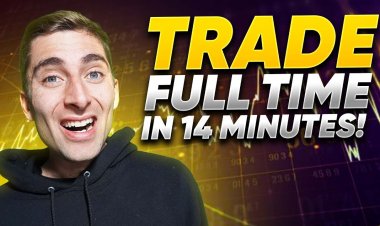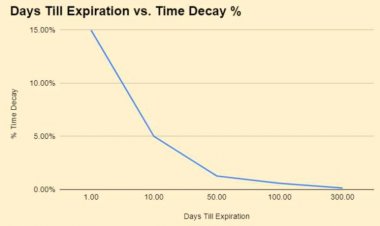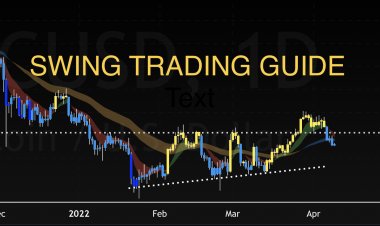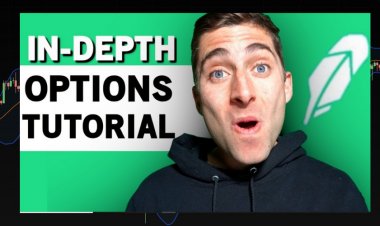The Poor Man's Covered Call: How to Utilize This Passive Income Strategy
In this blog, Matt talks about what the Poor Man’s Covered Call is and how you can utilize it. The Poor Man’s Covered call is an insane passive income strategy that allows you to do Covered Calls with a very low amount of money. Many traders don’t have the money to do proper Covered Calls, where you have to already own 100 shares of the stock. Stay tuned to learn how to do covered calls without having to pay for 100 shares of stock. Stay tuned!

In this video, Matt talks about the poor man's covered call. This is a great strategy for those who want to generate passive income but don't have the money to buy 100 shares of stock. Stay tuned to learn how to utilize this strategy and start generating passive income today!
Why Covered Calls?
The traditional covered call strategy is a great way to generate passive income. By writing covered calls, you can collect premium payments from other investors while still retaining the upside potential of the stock. This is a great strategy for those who want to generate a steady stream of income from their investments without having to sell their shares. The downside is this can be quite expensive for regular investors, that is where this alternative can be attractive!
Many traders don't have the capital to do proper covered calls, where you have to own 100 shares of the underlying stock. The poor man's covered call is a strategy that allows you to do a covered call with only owning a fraction of the stock. Inside this article, we will completely overview both strategies as well as how to utilize them properly.
Best and Worst Time to Sell Options
From my many years selling options, I have learned the hard way when selling options perform poorly and when they can allow my account to blossom like a butterfly.
Below is a cheat guide based on when to use what. Let's break it down:
Stock Uptrends (Best time to sell options): This is where covered calls and just naked stock will always have the most appreciation. Cash secured puts will lag in this scenario and not allow traders to maximize their portfolios. This is based on the fact that stock moving 10-30% in one month will beat the returns of most options sold. In fact, selling options at all in a major uptrend will greatly limit the gains possible.
Stock Downtrends (Worst time to sell options): This is where covered calls and just naked stock will do the most damage to your portfolio. Cash secured puts will not be as painful on portfolios during this time because you do not own the stock. Owning the stock and holding a covered call allows you to lose money from the stock losses in this scenario which can be quite large and greater than the premium. This is based on the fact that when a stock moves down 10-30% in one month, the option premiums collected will not make up that amount lost. In fact, selling options or owning the stock at all in a major downtrend will subject the trader to losses.
Covered Calls Requirements
Before going over poor man's covered calls, let's first go over the traditional Covered Calls strategy. A covered call is when you own shares of stock and sell calls against those shares. In order to sell one call option, you need exactly 100 shares of the stock, and for every 100 shares, you can sell another call option.
This creates an obligation to sell your stock at the strike price of the options if they are assigned (exercised by the buyer of the option) by another investor or trader.
Losing your stock may sound scary but there are some strategies to avoid it. In the long run, creating passive income from investments may outweigh the downsides.
Covered Call Benefits
One of the major benefits of writing call options is the option is traditionally out of the money. This is meant to take advantage of major time decay and profit from the option expiring worthless. If the option stays out of the money at the time of expiration, that is how it becomes worthless. Options only have intrinsic value at the time of expiration if they are in the money.
Having a call option expire in the money and losing your stock may not be a bad thing! When call options are sold at a higher strike price, this means that if the stock reaches that strike price, you will have made money from the appreciation.
For example, if your stock is at $10 and you write a call options for $13, the stock would have to move 30% for your option to be in the money. This is what makes selling call options a win-win-win.
Win: Option expires out of the money = full premium collected
Win: Option expires in the money = full premium collected
Win: Option expires in the money = stock appreciates in value
Underlying Stock Example
Below is an example of a covered call strategy, currently inside my account. For this scenario, FUBO stock is being bought which means at the current price of $10.63, the total cost of the long stock position would be $1063 in order to purchase 100 shares.
While this is the capital requirement needed to start this strategy now, these 100 shares could have been purchased at $5-7-9. Which lowers the amount of initial capital tied up in the stock and allows for greater returns.
Selling the Right Call Option
Once the buyer has the shares necessary, the next step is to pick a call option they feel comfortable selling. This depends on their risk appetite and their willingness to possibly lose their shares of the underlying stock.
Looking at the options chain below, the green line is the current stock price, and everything above it is considered "out of the money." This means if the stock doesn't move then all these options will expire worthless and allow the option seller to collect the full premium. The only value these options have currently is an extrinsic value which is mostly made up of time decay.
This gives us a range of different strike prices to choose from that total gains possible range from $28 to $5. As you can see, the riskier you want to be the higher premium that could possibly be brought in.
It is important to understand your risk of losing the stock which can be statistically calculated at any time. This number can be found in the chance of profit column. So we can see the highest strike price has a 93% chance of expiring worthless. The lowest strike price has a 74% chance of expiring worthless.
 Covered Calls Outcomes
Covered Calls Outcomes
This is where it might be scary to you. You probably have seen many margin calls and accounts lost overnight from traders not understanding the risk of short options. While it can be dangerous if not understood properly, we are going to attempt to give a detailed picture of the scenarios and choices possible.
First off, the avoid a dangerous margin call make sure you have the required shares or long call options for every single short call sold.
The most confusing scenario is if the option expires in the money at the time of expiration. This is where you will lose your stock, but there are some choices you have if you don't want that to happen.
SHORT OPTION GOES ITM
- BUY BACK SHORT OPTION - This is a strategy that can be done if you don't want to lose your stock. In this scenario, you will not keep the premium from the short option and in many cases, you will buy it back for a loss.
- LOSE STOCK + KEEP PREMIUM - This is a strategy that can be done if you don't mind losing your stock. In this scenario, you will keep the premium from the short option and get to sell your stock at the strike price of the short option.
- ROLL OPTION - This is a strategy that can be done if you don't want to lose your stock. In this scenario, you will not keep the premium from the short option, (possibly) buy it back for a loss, and sell another call option for a further expiration date and possibly a different strike price.
Rolling an option can be extremely complex that is why we will link a past blog we overviewed this with.
SHORT OPTION STAYS OTM
- ROLL OPTION - In this scenario, you may have made 80-90% of the premium from the call option but don't mind giving up the last little bit. Most options keep a very small amount of premium up until the moment they expire, so it can make sense to roll options once you captured a good amount.
- DO NOTHING
In the example, below you can see visually the line where the short option was sold. Underneath the line would be considered out of the money and above the line would be in the money. The difference between the stock price and the strike price is the possible appreciation that could be gain from the stock running.
Poor Man's Covered Call Requirements
The poor man’s covered call is a great strategy for those who don't have the money to do proper Covered Calls, where you have to already own 100 shares of the stock.
This is a cheaper entry into this strategy because the required entry is a long call option contract. Call option contracts can be as expensive or cheap as you find them but doing this strategy properly can be difficult with the wrong options.
In short, a poor man's covered call is created by buying a long call option contract and selling a short call option contract with different expiration dates. This is not unique as there are many names to it. Options traders also refer to this trade as a debit spread or diagonal trade because of the different expiration dates.
Step 1: The long Option - In the Money Strike Price
Traditionally, the poor man's covered call uses deep ITM strike options with longer expiration dates. This could be as far as 1-2 years expiration, which means an in-the-money option could be quite expensive. This doesn't mean the strategy won't work with 3-6-9 month options, but the best way to maximize it is with very far-out options past 12 months.
The option strike price works better being deep in the money because it allows the option seller to have more options possible to sell covered calls. The mitigate risk, the short option strike price needs to be above the long option strike price.
This will be very hard to create income from if the long option first chosen is out of the money. This would just mean less premium collected per week or month. That is why most choose deep ITM options.
In the example below, you can see the expiration date is about one year from today and the first option in the money costs $405 for the $10 strike price. If you were to do this strategy with traditionally covered calls it would cost over $1,000, which means you are saving 60% using the poor man's covered calls.
Step 2: The Short Out of the Money Option
The long option allows you to be protected and start the same exact strategy we discussed previously. The steps and outcomes are completely identical which makes this a lot less confusing.
The goal here from selling covered calls above the strike price of the long option and have it expire worthless. The only downside to this strategy is you REALLY don't want to option to expire in the money because if the long option has to be exercised you will be giving up the premium. This premium is $405, which is a heft amount and makes this strategy much riskier than the traditional.
Poor Man's Covered Call Outcomes
As stated, earlier the outcomes are completely identical with the small caveat of wanting to avoid assignment. This would mean losing all the premium from the long option contract which could be a lot of money.
People who utilize this strategy will buy back the short option contract much quicker before expiration and suffer a loss. The loss that occurred traditionally won't be more than the cost of the long option contract.
SHORT OPTION GOES ITM
- BUY BACK SHORT OPTION
- LOSE STOCK + KEEP PREMIUM
- ROLL OPTION
SHORT OPTION STAYS OTM
- ROLL OPTION
- DO NOTHING
Conclusion
Covered calls are a great way for long term investors to create a low risk income stream from a particular stock. The standard covered call trade can be tough for many early investors to get into who have less capital. That is the major benefit of the poor man's covered call, it calls for the same reduced risk but also reduced capital! For a fraction of the capital required, you can accomplish the same thing as the poor man's covered call.
Use BreadAlerts to Maximize Option Selling
If you are looking for a way to maximize your option selling, then you should definitely be using BreadAlerts. This tool will help you find the best opportunities to sell options and maximize your time! With BreadAlerts, we filter through thousands of stocks by the second to find the very best that meet our strict criteria. This tool is essential for any option seller, and it can help you save more time and not miss out on the best options to sell weekly!
Trade with us!
Looking for a more sophisticated and educational options trading experience, look no further than "Market Moves Premium Options Trading Group." Our exclusive 7-day membership offers swing trading set-ups, fast text signals, and +100 hours of educational content. Plus, you'll have access to live trading sessions twice per day. So if you're ready to take your options trading to the next level, join us today!
Financial Disclaimer: Market Moves LLC is a company that provides education in financial and stock market literacy. WE ARE NOT FINANCIAL ADVISORS. It is illegal for us to provide any financial advice to you. Under U.S. law, the only persons who can give you financial advice are those who are licensed financial advisors through the SEC. Results shown from Market Moves LLC or customers who use our product and/or service are individual experiences, reflecting real-life experiences. These are individual results, and results do vary. Market Moves LLC does not claim that they are typical results that consumers will generally achieve. Past performance does not guarantee future results. You should not rely on any past performance as a guarantee of future investment performance











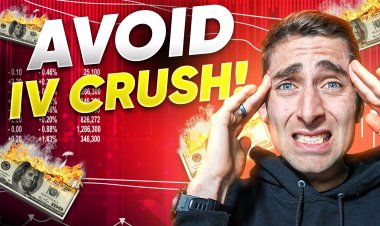
![Roth IRA Options Trading [Full Overview]](https://tradewithmarketmoves.com/uploads/images/2022/05/image_380x226_62704709195c1.jpg)
